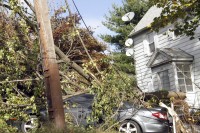Did You Know the SBA Helps Homeowners, Renters, Businesses and Private Nonprofits?

It seems to be a little known fact that the U.S. Small Business Administration does help homeowners and renters in disaster situations. That’s the message Richard Daigle, a spokesman for the SBA is trying to get out to the public before the December 31 applications deadline arrives.
In a recent interview with The White Plains Examiner, Daigle, who has been working at the Hurricane Sandy Disaster Recovery Center at the Westchester County Center, explained that most people assume the SBA only gives help to businesses, so they don’t look any further in this direction.
“When FEMA is activated in an area, the SBA is automatically activated in that area as well,” explained Daigle. “The difference is that FEMA funds are grants and not intended to satisfy the whole need. The grants are for immediate needs.”
According to Daigle, SBA has deeper pockets than FEMA and more money to give. This money is offered as disaster loans at low interest rates and is intended for use by nonfarm businesses, homeowners and renters, as well as private nonprofit organizations.
“The loans come directly from the federal government and include no closing costs,” Daigle said. The homeowner/renter rate can be as low as 1.688 percent with business loans at 4 percent.
Homeowner loans can be borrowed up to $200,000 for building and structural property loss and $40,000 for loss of personal items. Renters can claim up to $40,000 for personal content. Businesses can borrow up to $2 million for physical loss and economic injury.
“Even if a business was not physically hurt, if it was financially hurt, the owner can file a claim,” Daigle clarified, noting that the deadline to apply for physical losses is December 31, 2012. “The economic injury claims deadline is July 31, 2013, because the applicant will have to supply sufficient evidence that an economic loss was suffered,” he added.
In disaster situations, the purpose of the SBA is to cover losses not covered by or under covered by insurance. For example, if a house is lost during a flood but the owner did not have flood insurance, then SBA can step in.
Just after a disaster many people apply for help from FEMA. They receive a packet in the mail that contains information about the SBA and often because it uses the term “business” they are turned off and assume it does not relate to them, according to Daigle. Or, they assume they won’t qualify for the loan.
Daigle says this is a big mistake. “Everyone should apply if they have a loss,” he said. If they qualify for the loan, and the process is similar to applying for a loan from a bank, except the loans are reviewed and analyzed on a case-by-case basis, the borrower can decide not to take the loan if they don’t need it. This also applies to people waiting to find out what their insurance companies will cover. “Don’t wait,” advises Daigle. “Fill out the paperwork. Everything can be sorted out later.” Once the deadline date has passed it will be too late.
To apply for an SBA disaster loan call 1-800-659-2955, visit www.sba.gov and apply online, or go to any disaster recovery center such as the one currently operating at the Westchester County Center.
Once the completed loan application is received it takes 10 days or less to find out if the application has been approved or not. At this point there is usually some additional paperwork required and a closing date is set. After the closing date, it takes from two to three days for the money to be electronically deposited into the borrower’s account.
